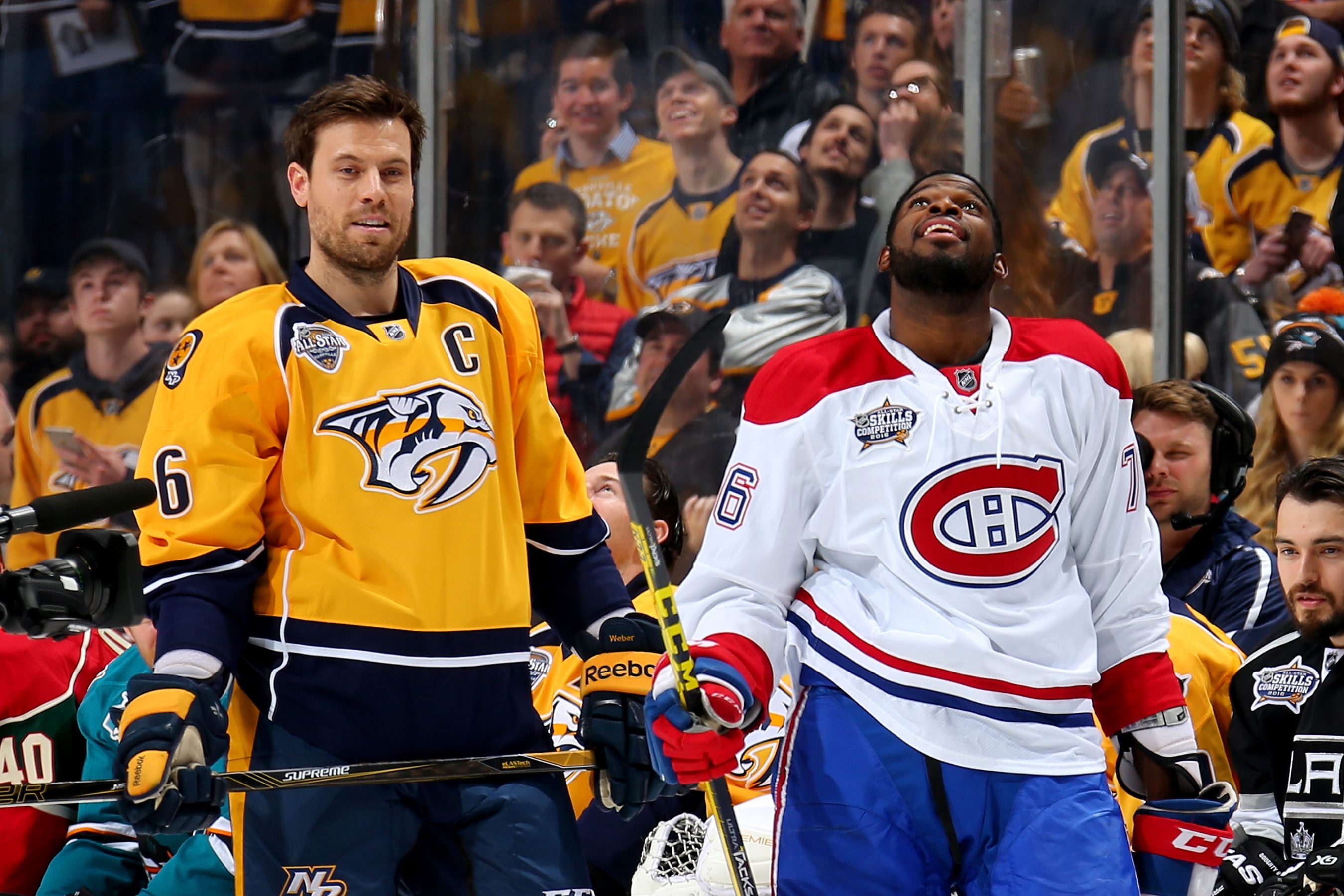One of the reasons the hockey offseason is fascinating is because, perhaps more than in any of the other three major American sports, bona fide superstars are constantly on the move. These trades shake up the NHL and drastically change the season’s outlooks for the teams involved. Teams that finish at the bottom of the pile in one season are legitimate contenders the next, and vice versa. Blockbuster trades and these massive turns of fate often go hand in hand, and are two of the aspects that make the National Hockey League so much damn fun to watch. In case you haven’t heard, the hockey community and general managers don’t really subscribe to the analytics fad sweeping American sports, as the NHL only placed one team (the Blackhawks, at #10) in the top 10 of ESPN’s Great Analytics Ranking in 2015. While the eye test might not be conducive to on-ice success (the forward-thinking Hawks have captured a third of the Stanley Cups this decade, after all), it certainly leads to some stunning trades and to some disgraced general managers.
With the NHL offseason finally behind us, let’s revisit some of the other recent deals that have altered the league landscape, and evaluate just how far their implications wound up reaching. We’ll look at the two types of trades that separate the NHL from the pack when it comes to generating exciting deals: the trade of the young star, and the star-for-star trade.
THE YOUNG GUNS
Could you imagine offering a trade for Joel Embiid to the Sam Hinkie-led 76ers? Or for Carlos Correa from the Astros? You’d get a hearty laugh and a dead phone line. In the NHL, however, young stars have been dealt on numerous occasions in the past decade. We’ll start with the deal that set off a chain reaction of colossal proportions between two of the league’s Original Six. On September 18, 2009, there were few hotter names in the league than Phil Kessel’s. Kessel had just potted 36 pucks on his way to helping the Boston Bruins reach the Eastern Conference Semifinals at just 21 years old. The 2006 Draft’s fifth overall pick could not come to terms with the B’s on a contract extension, however, and they stunningly traded Kessel to the Toronto Maple Leafs in a deal for the Leafs’ first-and-second-round picks in 2010 and their first in 2011. Kessel would get his deal soon after, signing a 5-year, $27 million ticket with Toronto.
It was a steep price to pay, but the Leafs and Brian Burke were convinced they could take their next step with Kessel on board. The opposite happened as the Leafs regressed to earning only 74 points, good for the 2nd overall pick in the Draft that was heading to Boston. The Bruins selected center Tyler Seguin of the Plymouth Whalers who, like Kessel, tore it up in his first three years in the show before proving unable to lock up after his entry-level deal expired. Bruins GM Peter Chiarelli moved Seguin in a deal, not unlike the one they had made four summers earlier, acquiring winger Loui Eriksson, Reilly Smith, Matt Fraser, and Joe Morrow for Seguin, Rich Peverley, and Ryan Button on July 4, 2013. Seguin and Kessel, at identical points in their careers with very similar production, both fetched the B’s a considerable amount, but Boston got much better return on their deal for Kessel with the draft picks they acquired. Eriksson and Morrow never panned out in Boston, while Smith left after two seasons for the Florida Panthers. The Bruins have built a contender today, but it’s hard not to play a game of what could have been had they kept Kessel and Seguin, two of the league’s finest scorers.
How about the already-infamous Jonathan Drouin-Mikhail Sergachev deal? Canadiens GM Marc Bergevin clearly hasn’t taken the trading wisdom he learned under Stan Bowman in Chicago earlier in his career with him to Quebec, as the Habs come out on the wrong side of a couple deals in this piece, but perhaps the most confounding remains Drouin-Sergachev. A talented but maddeningly inconsistent winger with attitude problems who had not lived up to his pedigree as 2013’s third overall pick, Drouin had been on the trade block for over a calendar year when the Habs scooped him up in summer 2017. Unable to see the writing on the wall for his club, Bergevin sent the Lightning star Russian defensive prospect Mikhail Sergachev, a steal at 9th overall in 2016. Drouin gleefully inked a 6-year, $33 million contract while watching the team around him disintegrate almost overnight, while Sergachev was electric last season, producing 40 points for the best team in the Eastern Conference. The Lightning are Cup favorites this season and will be paying Sergachev all of $894,166; the Canadiens are facing a long, ugly rebuild that will be made even tougher after they let go of the foremost candidate who could have taken them out of the league cellar when the time came. The best comparison for Steve Yzerman and Marc Bergevin discussing trades casts Bergevin as the boy in Shel Silverstein’s “Smart” trading his dollar bill for two quarters, “Because two is more than one.” Still, the swap of two recent top-five picks makes for great front-of-the-sports-page news.
Then, there was this summer’s Noah Hanifin trade. Hanifin, the fifth overall pick in the draft three years ago, was a steady presence on the blue line almost from the day he walked into the Carolina Hurricanes’ dressing room, despite playing on some very shaky teams in his tenure there. Still, sixty-year-old GM Don Waddell felt it was time to move on from Hanifin and 23-year-old center Elias Lindholm, another fifth overall pick (in 2013) and one of the Canes’ few consistent point-producers through the last few campaigns. The two players were offloaded together to the Flames for Dougie Hamilton, who has been rumored to have had a poor locker-room presence in Calgary. Still, Hamilton has unquestionable ability; the 2011 ninth overall pick has the reach at 6’6” that makes old-school talent evaluators salivate”, and he’s put up more than forty points each of the last four seasons. Time will tell who’s going to get the best of this fascinating deal of former top-ten selections.
STAR FOR STAR
Another type of deal almost never seen in the other ranks of American pro sports is the star-for-star deal. With due respect to the Kyrie/Isaiah Thomas deal a year ago and the Kawhi Leonard/DeMar DeRozan trade this year, hockey paces them all in this regard. Honorable mentions in the last three seasons alone include Brandon Saad going back to the Blackhawks for Artemi Panarin, Matt Duchene to the Senators with Kyle Turris heading to Nashville, the Senators and Kings seeing what Marian Gaborik and Dion Phaneuf, respectively, had left in the tank, and, to a lesser extent, Alex Galchenyuk going to the desert to play for the Arizona Coyotes this offseason with Max Domi headed back to Montreal. Hell, Sergachev-for-Drouin and Hanifin-for-Hamilton could be included here. Still, there are two deals that stand head and shoulders above the rest in this category, and they happened on June 29, 2016, seventeen minutes apart.
First, a swap for which there exist no direct flights: at 3:34 PM E.T., the Edmonton Oilers trade Taylor Hall to New Jersey in exchange for Adam Larsson. The Oilers, perhaps the worst-managed team in modern North American sports history, were shellacked almost immediately for this deal, but Chiarelli (the same man who dealt Kessel and Seguin while with the Bruins) might have been crucified outside brand-new Rogers Place had the Oilers faithful known what’s happened since the deal. Hall, 2010’s first overall pick, needed a season to get his feet under him in Newark, but, boy, once he did, he absolutely exploded. After putting up 53 points in 72 games for a putrid Devils squad that finished with the league’s fourth-worst record in the 2016-2017 season, Hall took the league by storm in last year, racking up 93 points in 76 games while playing with merely serviceable linemates, dragging the Devils back to the playoffs in the Metropolitan Division on his way to winning the Hart Trophy as league MVP. On board for two more seasons at only $6 million per year, Hall is one of the best bargains in the league and will look to do damage with sophomore rising star center Nico Hischier. Meanwhile, up in Alberta, poor Adam Larsson. Never more than a second-pairing, stay-at-home defenseman, Larsson has been hassled ad infinitum by Oilers fans to live up to his end of the trade and to his draft position (4th overall in 2011) by producing points. Though Edmonton followed the heroics of Connor McDavid to the second round of the playoffs in 2016-17, not even the greatest player in the game could save them last season, as the Oilers missed the playoffs while Larsson regressed to only 13 points. Hockey fans still lament not being able to see more of McDavid playing alongside a truly game-breaking winger like Hall.
With the hockey world still digesting the news of the Hall/Larsson swap, lightning struck twice at 3:51. Supremely talented, but always loose and jovial, P.K. Subban never seemed to settle in hockey-crazed Montreal. Despite three straight playoff appearances from 2013-15, the Habs were never able to break through to the Stanley Cup Finals during Subban’s time wearing the sweater, and P.K. often found himself getting ripped despite his statistically solid performances in the playoffs. In 2015-16, Montreal missed the playoffs altogether despite Subban producing 0.75 PPG on the back end. Marc Bergevin had seen enough, however, and shipped Subban straight up to the Music City for Shea Weber. Weber, for his part, had chipped in 20 goals from the blue line the previous season, but had posted a -7 +/- despite the Preds’ 96-point regular season total. Four years into his shocking 14-year, $110 million ticket, Weber was a sunk cost waiting to happen at 30 years old in 2015-16. Nevertheless, Bergevin still brought him on, and we all know the ending to this story. Division winners in Weber’s first season, the Habs totally unraveled on their way to recording only 71 points last campaign and are looking at a long season ahead in 2018-19 that Weber won’t be a part of, as he’ll miss five to six months recovering from surgery on his torn meniscus in July. Weber is still on the books for the next eight seasons. The Predators, meanwhile, have assembled arguably the best defensive corps in the league, led by Subban. They reached the Cup Finals in Subban’s first season, losing in six games to the Penguins before falling in seven in the second round of the playoffs this season to the Winnipeg Jets. Subban was an All-Star in 2017-18 and finished 3rd in Norris Trophy voting.The NHL regular season gets underway when the Toronto Maple Leafs host the Canadiens in John Tavares’ debut on Wednesday at 7 PM E.T. Half an hour later, the Washington Capitals will be raising their Stanley Cup banner inside Capital One Arena against the Boston Bruins. Hockey season is well and truly here and at The Voice, almost everybody is amped for the puck to officially drop. Hopefully I’ll be writing some more articles as the season progresses, and be sure to tune in to the positively electric “Pucking Listen to Brad and Will,” the official hockey podcast of the Voice Sports Network (first episode dropping soon, name subject to change).
Image Credit: hockeyinsideout.com





